Kinematics Reconstruction by Scalable Double Step Registration (SDSR)
Anatomically correct human motion visualization and interpretation can only be implemented from accurate subject-specific data collected from daily clinical practice. This involves data fusion of highly heterogeneous data such as motion analysis (MA) and 3D models obtained from medical imaging (MI). A number of pathologies (e.g., cerebral palsy, diplegia, brain stroke) lead to disorders of the patient's muscle system that can show a variety of primary disorders (i.e., spasticity, weakness, lack of coordination). Typically, data necessary for bones and soft tissue (ST) registration are: - 3D models obtained from MI; - spatial locations of palpated anatomical landmarks (ALs) on the 3D models and the subject undergoing the motion analysis; - joint kinematics (JK); - motion analysis data collected in the same technical frame as the palpated ALs and results of soft tissue reconstruction on generic skeletons. The aim of this research is developing a scalable double-step registration (SDSR) method aiming at combining single joint physiological kinematics with overall lower limb segment pose. Additionally, ST data are fused from a template database to allow analysis of the ST behavior during particular motion task performed by the subject under investigation.
Top image: schematic presentation of the workflow for selected generic model registration to the volunteer's kinematics and manual palpation data. Bottom image: SGM model obtained from the fusion of GM data with motion data obtained from two volunteers (i.e., showing different size). The illustrated motion is squatting. The first row shows from the left to right: the upright pose and three frames of the reconstructed motion (frontal view, results for both volunteers are displayed on each other for comparison). The top right image shows the same models along a sagittal plane (note the anatomically correct knee and ankle behaviour). The second row shows results for the two volunteers separately. |
Need more information? Please contact ![]() !
!
 Laboratory of Anatomy, Biomechanics and Organogenesis
Laboratory of Anatomy, Biomechanics and Organogenesis
